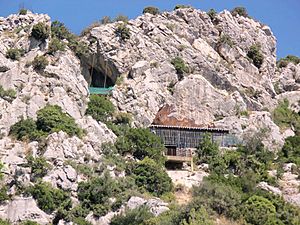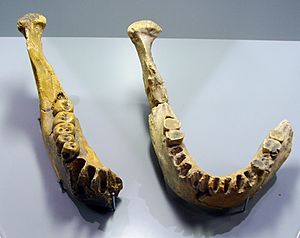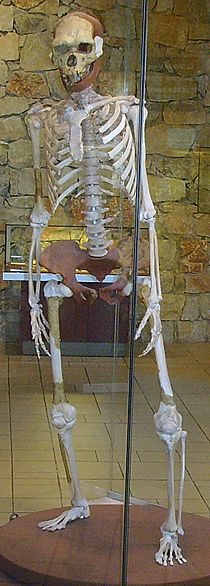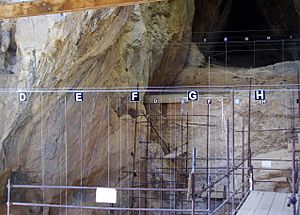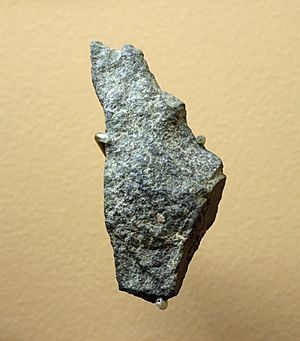Tautavel Man facts for kids
Quick facts for kids Tautavel Man |
|
|---|---|
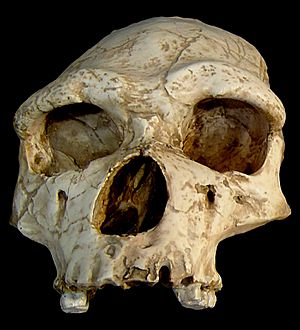 |
|
| Reconstructed face of Arago 21 | |
| Scientific classification |
|
| Kingdom: | Animalia |
| Phylum: | Chordata |
| Class: | Mammalia |
| Order: | Primates |
| Suborder: | Haplorhini |
| Infraorder: | Simiiformes |
| Family: | Hominidae |
| Subfamily: | Homininae |
| Tribe: | Hominini |
| Genus: | Homo |
| Species: | |
| Subspecies: |
†H. e. tautavelensis
|
| Trinomial name | |
| Homo erectus tautavelensis de Lumley and de Lumley, 1979
|
|
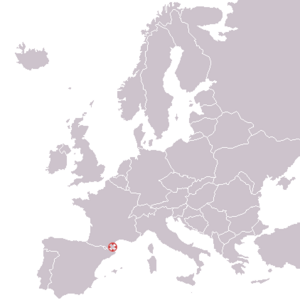 |
|
| Site of discovery in Tautavel, France | |
Tautavel Man refers to a group of ancient humans who lived in the Caune de l’Arago in Tautavel, France. They lived there about 550,000 to 400,000 years ago. These humans are often seen as a link between earlier human types and the later Neanderthals. Scientists sometimes call them Homo heidelbergensis or a type of Homo erectus called H. e. tautavelensis.
The skull of Tautavel Man, put together from fossil pieces, looks a lot like H. erectus. Their brains were about 1,166 cubic centimeters in size. Their bodies were quite strong and sturdy. They might have been around 166 cm (about 5 feet 5 inches) tall.
The Caune de l'Arago cave is high up on a cliff, 80 meters (262 feet) above a river. It looks out over a wide plain. The area around the cave changed a lot over time. It went from warm, wet forests to cold, dry grasslands. Tautavel Man lived in the cave during these changes.
They hunted many different animals, like red deer, fallow deer, horse, and reindeer. They used Acheulean stone tools. Most of their tools were smaller, sharpened tools like scrapers. They didn't make many large bifaces (hand axes). Some evidence suggests they might have practiced ritual cannibalism. There is no sign of fire use until about 400,000 years ago.
Contents
Discovering Tautavel Man
People first found animal fossils in the Caune de l’Arago cave in 1828. But it wasn't until 1963 that Jean Abélanet found stone tools there. This discovery made French archaeologist Henry de Lumley want to look for human remains.
In 1964, Henry de Lumley found human bones. In 1971, he found the first face fossil, called Arago 21. He and his wife, Marie-Antoinette de Lumley, described these finds. They realized these remains were older than the Neanderthals in Europe.
Scientists saw similarities between Tautavel Man and both Homo erectus and Neanderthals. They thought Tautavel Man might be a missing link between these two groups. For a while, they were called "Pre-Neanderthals." In 1979, the de Lumleys suggested the name "H. e. tautavelensis." However, many other scientists preferred to classify them as Homo heidelbergensis. This species was thought to be the direct ancestor of Neanderthals.
The skull of Tautavel Man is hard to study because the fossils (Arago 21 and 47) were crushed. Scientists have made many attempts to rebuild the skull's shape. These reconstructions helped them compare Tautavel Man to other ancient humans. In 2015, Marie-Antoinette de Lumley argued that H. e. tautavelensis was a separate subspecies. She focused on how similar they were to H. erectus.
By 2014, scientists had found 148 human bones from the Caune de l'Arago. These included 123 teeth and 5 jawbones. These bones belonged to 30 different individuals, including 18 adults and 12 young people.
Based on their teeth, about 30% of these individuals died between ages 7 and 12. About 37% died between 18 and 30. Only 3% lived past 40. This means the average life expectancy was about 20–25 years.
Body Features
The reconstructed skull of Tautavel Man looks a lot like H. erectus. It has strong brow ridges and a forehead that slopes back. The face is relatively low. Males were much more robust (stronger and bigger) than females.
However, Tautavel Man's skull also has some differences from H. erectus. It has a wider base and cheekbones that point more forward. Compared to H. heidelbergensis, Tautavel Man had a longer skull and a smaller brain. This suggests they kept more ancient features, like H. erectus.
The Tautavel skull is about 199 mm (7.8 inches) long. This is similar to H. erectus skulls. It is shorter than Neanderthal skulls, which had larger braincases. The skull is 144 mm (5.7 inches) wide. Modern human skulls are about 176x145 mm for men and 171x140 mm for women.
Tautavel Man's face stuck out more from the back of the skull. This is similar to H. erectus and different from Neanderthals and modern humans. The jawbones of Tautavel Man were very strong, especially in males. This shows they had powerful jaw muscles. Their teeth were quite large for ancient humans in Europe.
In 1983, scientists estimated Tautavel Man's brain size to be 1,166 cubic centimeters. This is similar to Peking Man from China. It is also on the smaller side of the range for modern human brains.
The rest of Tautavel Man's skeleton was also very strong and thick. This might have been because of the cold climate, lots of physical activity, or fast bone growth when they were young. Their leg bones were very robust, like Neanderthals. This could have helped them deal with cold weather or intense physical activity.
Daily Life and Tools
Living Environment
The Caune de l’Arago cave is currently 35 meters (115 feet) long and 5 to 9 meters (16 to 30 feet) wide. Over hundreds of thousands of years, parts of the cave walls and roof have likely fallen in. The cave deposits, where fossils are found, go down 11 meters (36 feet).
These deposits show that humans lived in the cave from about 550,000 to 400,000 years ago. Most human remains were found in a layer called bed G, which is about 455,000 years old. The cave is one of the oldest known inhabited caves in the Pyrenees mountains.
The area around the cave changed between forests and grassy plains. During forest times, animals like red deer, fallow deer, and rhinoceros lived there. Predators like cave lynx, cave lions, and wolves were also present. During cold, dry times, animals like horse, reindeer, and steppe bison were common. The cave also has the earliest proof of beaver hunting.
Scientists can tell when the humans lived in the cave by looking at the teeth of young animals. This shows that Tautavel Man lived in the cave for long periods during some times. At other times, they only stayed for a few months. Human baby teeth found in the cave suggest that whole families, including children, lived there.
Tools and Fire
Tautavel Man made stone tools. Most of their tools were smaller, sharpened tools. These included simple scrapers and denticulate tools (tools with a saw-like edge). They also made some larger tools like choppers and a few bifaces (hand axes). Bifaces are tools that are perfectly symmetrical on both sides. Some people think they were made this way for beauty.
They used different types of rock for their tools. They could find lower quality rocks like quartz and sandstone in the river. Higher quality rocks like flint and quartzite, better for making sharp tools, were found further away. They mostly used vein quartz from the river. This was because it was common and made good cutting edges for their scrapers.
Evidence of fire is only found in the upper part of bed C, dating to about 400,000 years ago. This suggests that humans might have started controlling fire better around this time. Or they might have found better ways to keep fires going.
See also
 In Spanish: Hombre de Tautavel para niños
In Spanish: Hombre de Tautavel para niños


